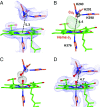Snapshot of an oxygen intermediate in the catalytic reaction of cytochrome c oxidase
- PMID: 30808749
- PMCID: PMC6397517
- DOI: 10.1073/pnas.1814526116
Snapshot of an oxygen intermediate in the catalytic reaction of cytochrome c oxidase
Abstract
Cytochrome c oxidase (CcO) reduces dioxygen to water and harnesses the chemical energy to drive proton translocation across the inner mitochondrial membrane by an unresolved mechanism. By using time-resolved serial femtosecond crystallography, we identified a key oxygen intermediate of bovine CcO. It is assigned to the PR-intermediate, which is characterized by specific redox states of the metal centers and a distinct protein conformation. The heme a3 iron atom is in a ferryl (Fe4+ = O2-) configuration, and heme a and CuB are oxidized while CuA is reduced. A Helix-X segment is poised in an open conformational state; the heme a farnesyl sidechain is H-bonded to S382, and loop-I-II adopts a distinct structure. These data offer insights into the mechanism by which the oxygen chemistry is coupled to unidirectional proton translocation.
Keywords: X-ray free electron laser; bioenergetics; catalytic intermediates; complex IV; crystallography.
Conflict of interest statement
The authors declare no conflict of interest.
Figures






Similar articles
-
X-ray structures of catalytic intermediates of cytochrome c oxidase provide insights into its O2 activation and unidirectional proton-pump mechanisms.J Biol Chem. 2020 Apr 24;295(17):5818-5833. doi: 10.1074/jbc.RA119.009596. Epub 2020 Mar 12. J Biol Chem. 2020. PMID: 32165497 Free PMC article.
-
The protein effect in the structure of two ferryl-oxo intermediates at the same oxidation level in the heme copper binuclear center of cytochrome c oxidase.J Biol Chem. 2013 Jul 12;288(28):20261-6. doi: 10.1074/jbc.M113.468488. Epub 2013 May 30. J Biol Chem. 2013. PMID: 23723073 Free PMC article.
-
Respiratory conservation of energy with dioxygen: cytochrome C oxidase.Met Ions Life Sci. 2015;15:89-130. doi: 10.1007/978-3-319-12415-5_4. Met Ions Life Sci. 2015. PMID: 25707467 Review.
-
Detection of a Geminate Photoproduct of Bovine Cytochrome c Oxidase by Time-Resolved Serial Femtosecond Crystallography.J Am Chem Soc. 2023 Oct 18;145(41):22305-22309. doi: 10.1021/jacs.3c07803. Epub 2023 Sep 11. J Am Chem Soc. 2023. PMID: 37695261 Free PMC article.
-
Structural and functional mechanisms of cytochrome c oxidase.J Inorg Biochem. 2025 Jan;262:112730. doi: 10.1016/j.jinorgbio.2024.112730. Epub 2024 Sep 8. J Inorg Biochem. 2025. PMID: 39276716 Review.
Cited by
-
Review of serial femtosecond crystallography including the COVID-19 pandemic impact and future outlook.Structure. 2023 Nov 2;31(11):1306-1319. doi: 10.1016/j.str.2023.10.005. Epub 2023 Oct 27. Structure. 2023. PMID: 37898125 Free PMC article. Review.
-
Heme-copper and Heme O2-derived synthetic (bioinorganic) chemistry toward an understanding of cytochrome c oxidase dioxygen chemistry.J Inorg Biochem. 2023 Dec;249:112367. doi: 10.1016/j.jinorgbio.2023.112367. Epub 2023 Sep 9. J Inorg Biochem. 2023. PMID: 37742491 Free PMC article. Review.
-
Co-flow injection for serial crystallography at X-ray free-electron lasers.J Appl Crystallogr. 2022 Feb 1;55(Pt 1):1-13. doi: 10.1107/S1600576721011079. eCollection 2022 Feb 1. J Appl Crystallogr. 2022. PMID: 35153640 Free PMC article.
-
Advances in integrative structural biology: Towards understanding protein complexes in their cellular context.Comput Struct Biotechnol J. 2020 Dec 3;19:214-225. doi: 10.1016/j.csbj.2020.11.052. eCollection 2021. Comput Struct Biotechnol J. 2020. PMID: 33425253 Free PMC article. Review.
-
Going around the Kok cycle of the water oxidation reaction with femtosecond X-ray crystallography.IUCrJ. 2023 Nov 1;10(Pt 6):642-655. doi: 10.1107/S2052252523008928. IUCrJ. 2023. PMID: 37870936 Free PMC article.
References
-
- Yoshikawa S, Shimada A. Reaction mechanism of cytochrome c oxidase. Chem Rev. 2015;115:1936–1989. - PubMed
-
- Belevich I, Verkhovsky MI. Molecular mechanism of proton translocation by cytochrome c oxidase. Antioxid Redox Signal. 2008;10:1–29. - PubMed
-
- Han S, Takahashi S, Rousseau DL. Time dependence of the catalytic intermediates in cytochrome c oxidase. J Biol Chem. 2000;275:1910–1919. - PubMed
-
- Morgan JE, Verkhovsky MI, Palmer G, Wikström M. Role of the PR intermediate in the reaction of cytochrome c oxidase with O2. Biochemistry. 2001;40:6882–6892. - PubMed
-
- Morgan JE, Li PM, Jang DJ, el-Sayed MA, Chan SI. Electron transfer between cytochrome a and copper A in cytochrome c oxidase: A perturbed equilibrium study. Biochemistry. 1989;28:6975–6983. - PubMed
Publication types
MeSH terms
Substances
Associated data
- Actions
- Actions
- Actions
Grants and funding
LinkOut - more resources
Full Text Sources
Other Literature Sources
Medical

